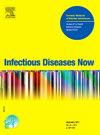Risk factors for clinical treatment failure regarding carbapenem-resistant Enterobacterales in the southwestern United States
IF 2.2
4区 医学
Q2 INFECTIOUS DISEASES
引用次数: 0
Abstract
Background
Rates of carbapenem resistant Enterobacterales (CRE)-related infections in the United States have continued to rise, leading to significant morbidity and mortality. Klebsiella pneumoniae carbapenemases (KPC) have been the most common carbapenemase in the United States; over time, however, a shift has occurred in some regions.
Methods
A multicenter, retrospective observational study was performed across a large-scale healthcare system of 33 acute care hospitals in the southwestern United States, primarily Arizona. Patients were included if they were ≥ 18 years old with resistance to at least one carbapenem from January 1st, 2023 to July 31st, 2023.
Results
Among 169 included patients, the most common CRE species was Klebsiella pneumoniae (82 %) with the most common identified carbapenemase being metallo beta lactamase (MBL) (76 %), the majority of which were New Delhi metallo-beta-lactamases (NDMs). Multivariable logistic regression was performed to determine risk factors for treatment failure regarding CRE infections. This model found renal replacement therapy [OR 2.44 (95 % CI 1.04–5.71)], prior hospitalization within 90 days of index culture [OR 2.69 (95 % CI 1.12–6.47), and admission to the ICU [OR 5.55 (95 % CI 2.58–11.93)] to be statistically significant risk factors for treatment failure.
Conclusions
Our study highlights the alarming rise of NDM-producing CRE’s in the southwestern US, primarily Arizona, along with the importance of closely assessing patient risk factors in view of deciding on appropriate empiric therapy.
美国西南部耐碳青霉烯肠杆菌临床治疗失败的危险因素
背景:在美国,碳青霉烯耐药肠杆菌(CRE)相关感染率持续上升,导致显著的发病率和死亡率。肺炎克雷伯菌碳青霉烯酶(KPC)是美国最常见的碳青霉烯酶;然而,随着时间的推移,一些地区发生了转变。方法:一项多中心、回顾性观察性研究在美国西南部(主要是亚利桑那州)33家急性护理医院的大型医疗保健系统中进行。在2023年1月1日至2023年7月31日期间,年龄 ≥ 18 岁且对至少一种碳青霉烯类药物耐药的患者纳入研究。结果:169例患者中,最常见的CRE菌种为肺炎克雷伯菌(82% %),最常见的碳青霉烯酶为金属β -内酰胺酶(MBL)(76 %),其中以新德里金属β -内酰胺酶(NDMs)居多。采用多变量logistic回归来确定CRE感染治疗失败的危险因素。该模型发现肾脏替代治疗[OR 2.44(95 % CI 1.04-5.71)]、指数培养后90 天内住院[OR 2.69(95 % CI 1.12-6.47)]和入住ICU [OR 5.55(95 % CI 2.58-11.93)]是治疗失败的有统计学意义的危险因素。结论:我们的研究强调了ndm产生的CR在美国西南部(主要是亚利桑那州)的惊人增长,以及在决定适当的经验治疗时密切评估患者风险因素的重要性。
本文章由计算机程序翻译,如有差异,请以英文原文为准。
求助全文
约1分钟内获得全文
求助全文
来源期刊

Infectious diseases now
Medicine-Infectious Diseases
CiteScore
7.10
自引率
2.90%
发文量
116
审稿时长
40 days
 求助内容:
求助内容: 应助结果提醒方式:
应助结果提醒方式:


